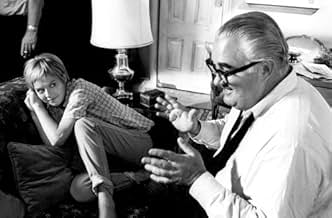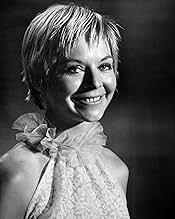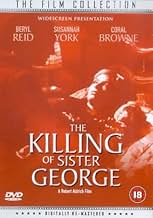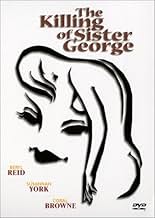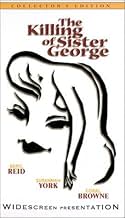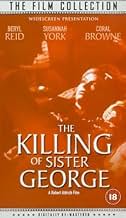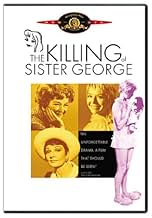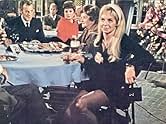PUNTUACIÓN EN IMDb
7,0/10
2,7 mil
TU PUNTUACIÓN
La "hermana George" es un personaje de culebrón "matada" a causa de falta de audiencia, con consecuencias en la vida de la actriz.La "hermana George" es un personaje de culebrón "matada" a causa de falta de audiencia, con consecuencias en la vida de la actriz.La "hermana George" es un personaje de culebrón "matada" a causa de falta de audiencia, con consecuencias en la vida de la actriz.
- Dirección
- Guión
- Reparto principal
- Premios
- 1 nominación en total
Reseñas destacadas
I did not see the stage play upon which this film is based (too young) but, based on its own merits, this film surely deserves a closer look.
The central trio of performers (Reid, York, Browne) provide career "bests" and there are some amusing vignettes from the others (Fraser, in particular, as a truly odious soap actor).
The much-discussed sex scene is, by today's standards (and, it would seem, even those of the 1960s stage play), tame, but its real value as a display of the shift of power between the three central characters is very neatly worked through in the closing quarter.
The final five minutes of (self-) destruction is heartbreaking, with excellent use made of the music track.
In short: miss it and miss out.
The central trio of performers (Reid, York, Browne) provide career "bests" and there are some amusing vignettes from the others (Fraser, in particular, as a truly odious soap actor).
The much-discussed sex scene is, by today's standards (and, it would seem, even those of the 1960s stage play), tame, but its real value as a display of the shift of power between the three central characters is very neatly worked through in the closing quarter.
The final five minutes of (self-) destruction is heartbreaking, with excellent use made of the music track.
In short: miss it and miss out.
Anyone who likes gritty, clever, slightly comical drama should see this one. The plot is simple enough - an alcoholic gay actress worried about her future in a top Coronation Street-style soap opera - but the way the film is put together is pithy without being too complex - the characterisations are brilliantly satirical, showing up the worst side of the soap opera industry and its catty, backstabbing nature. You don't find yourself feeling sorry for anyone at the end of it apart from perhaps Susannah York. Lots of London-in-the-1960s location filming and familiar faces - I'm only surprised that John Le Mesurier doesn't appear in it. In a word - absorbing. Why don't they make them like this anymore?
Seeing Beryl Reid mouth silently a four-letter swear word when such things didn't happen in films and drunkenly canoodling with two young nuns in the back of a London cab is both quite outstanding and rather lovable.
Miss Reid, who I only got to see in my childhood as a twee, granny-like innocent (the sort that she plays for real in a TV serial as Sister George, a homely district nurse), I found The Killing Of... both delicious and ever astounding in its frankness and of her rather warped relationship with the much younger Susannah York.
Warped, not because of the age difference, nor of their same-sex partnership, but because June Buckridge (Reid) has a cruel streak that is borne out by her playing sadistic mind games with Alice "Childie" (York).
Sister George, in the best tradition of TV soaps, is being killed off, to make way for an Australian replacement. Hence June's venomous outpourings and increasingly erratic behaviour.
Equally interesting is the London of the late '60s, both in its landmarks but also its people and fashions, whether that's in how they live and/or how they dress and present themselves.
Though real soaps cover such material freely and openly these days, 42 years ago, it must have been a very different kettle of fish. Lesbianism back in those days was not only considered immoral but also a mental aberration and had to be so hidden, in an attempt to prove to those 'righteous' souls that it did not exist. Therefore, it must have been a very brave undertaking as a film, though it originated as a play, written by Frank Marcus.
Having now seen it again, I consider Robert Aldrich's ground-breaking film to be a bit of a classic and one, which, no doubt I'll want to see again in a few years time. It really is a piece of British cinematic history.
Miss Reid, who I only got to see in my childhood as a twee, granny-like innocent (the sort that she plays for real in a TV serial as Sister George, a homely district nurse), I found The Killing Of... both delicious and ever astounding in its frankness and of her rather warped relationship with the much younger Susannah York.
Warped, not because of the age difference, nor of their same-sex partnership, but because June Buckridge (Reid) has a cruel streak that is borne out by her playing sadistic mind games with Alice "Childie" (York).
Sister George, in the best tradition of TV soaps, is being killed off, to make way for an Australian replacement. Hence June's venomous outpourings and increasingly erratic behaviour.
Equally interesting is the London of the late '60s, both in its landmarks but also its people and fashions, whether that's in how they live and/or how they dress and present themselves.
Though real soaps cover such material freely and openly these days, 42 years ago, it must have been a very different kettle of fish. Lesbianism back in those days was not only considered immoral but also a mental aberration and had to be so hidden, in an attempt to prove to those 'righteous' souls that it did not exist. Therefore, it must have been a very brave undertaking as a film, though it originated as a play, written by Frank Marcus.
Having now seen it again, I consider Robert Aldrich's ground-breaking film to be a bit of a classic and one, which, no doubt I'll want to see again in a few years time. It really is a piece of British cinematic history.
I don't give many movies 10/10, but this black comedy-drama gets my vote, for fine acting, production values, and of course its place in movie history in the frank portrayal of lesbian relationships.
Others have & will comment on the latter, so I'll point out some of the other aspects of this fine film. The combination of comedy with personal tragedy poses difficult problems both for the writer & director; here they both succeed brilliantly.
The three principals' performances are riveting. I particularly liked the ambiguity of Coral Brown's portrayal of Mercy Croft; watch her carefully in the tight closeups in the gay club, and notice how the down-turned mouth at times hides a hint of a self-satisfied smile.
The cinematography deserves special mention. The use of colour is beautiful; I was reminded of "The Umbrellas of Cherbourg", but it never steps over the line into unreality. On the contrary, the alleys of London, the TV studio and above all the stairs and corridor of the flat are supremely realistic. Most unusual is the use of chiaroscuro, the interplay of light-and-shadow, seldom seen outside of black & white films. In so many colour films the light appears to come from some amorphous omnidirectional source out of science fiction; great for lighting everything and everybody evenly, but unrealistic and DULL. Look at the shadows as Beryl Reid ('George') enters the apartment building and climbs the stairs, or in some of the bedroom scenes. Apart from its other many virtues, this movie held my attention as a fine piece of film-making.
All in all, a masterpiece; my one regret is that it was shown on TV in pan-and-scan. It IS now available in DVD - in several formats & regions - so I look forward to watching it again in its original form.
Others have & will comment on the latter, so I'll point out some of the other aspects of this fine film. The combination of comedy with personal tragedy poses difficult problems both for the writer & director; here they both succeed brilliantly.
The three principals' performances are riveting. I particularly liked the ambiguity of Coral Brown's portrayal of Mercy Croft; watch her carefully in the tight closeups in the gay club, and notice how the down-turned mouth at times hides a hint of a self-satisfied smile.
The cinematography deserves special mention. The use of colour is beautiful; I was reminded of "The Umbrellas of Cherbourg", but it never steps over the line into unreality. On the contrary, the alleys of London, the TV studio and above all the stairs and corridor of the flat are supremely realistic. Most unusual is the use of chiaroscuro, the interplay of light-and-shadow, seldom seen outside of black & white films. In so many colour films the light appears to come from some amorphous omnidirectional source out of science fiction; great for lighting everything and everybody evenly, but unrealistic and DULL. Look at the shadows as Beryl Reid ('George') enters the apartment building and climbs the stairs, or in some of the bedroom scenes. Apart from its other many virtues, this movie held my attention as a fine piece of film-making.
All in all, a masterpiece; my one regret is that it was shown on TV in pan-and-scan. It IS now available in DVD - in several formats & regions - so I look forward to watching it again in its original form.
Robert Aldrich is a director who rarely gets the attention he deserves. Ridiculously versatile he made the fascinating Film Noir 'Kiss Me Deadly', the gothic black comedy 'Whatever Happened To Baby Jane?', and the macho "tough guys on a mission" action classic 'The Dirty Dozen' to name just three in a long career. Just to emphasize that he could do just about anything, one of the first movies he made after 'The Dirty Dozen' was 'The Killing Of Sister George'. It's hard to imagine two more different movies! George is a very English picture about a much loved soap opera star (played by Beryl Reid) who has to juggle a career crisis with a complex lesbian relationship (her lover being played by Susanna York). Reid was well known to British audiences through her TV work, especially a couple of highly popular John Le Carre adaptations. Reid originated the Sister George role on the stage and she really makes the most of it in this movie. Her performance is terrific, hilariously bitchy and also very sad and pathetic. York is also good, and the lesbian subject matter must have been very shocking for the time. It may look a little dated now, but in context it is quite sensitively handled. There are some great actors in the supporting cast, most notably Coral Browne ('Theatre Of Blood') who plays a TV producer who has her eye on York. 'The Killing Of Sister George' deserves a bigger audience. I highly recommend it and hope that anyone who enjoys it looks further into the career of the Robert Aldrich, a seriously underrated film maker!
¿Sabías que...?
- CuriosidadesThe lesbian lovemaking scene so disgusted Robert Aldrich's longtime composer friend Frank De Vol that he quit the production and didn't work with Aldrich for several years.
- PifiasWhen George asks for a pint of beer the waiter arrives with it on a tray and it is half full with half a glass of head but when he puts it on the table it's much fuller, with only about an inch of head on it.
- Créditos adicionalesDuring the opening credits, the picture distractingly flips from left to right as the main character travels through claustrophobia-inducing alleyways.
- ConexionesFeatured in Before Stonewall (1984)
Selecciones populares
Inicia sesión para calificar y añadir a tu lista para recibir recomendaciones personalizadas
- How long is The Killing of Sister George?Con tecnología de Alexa
Detalles
- Fecha de lanzamiento
- País de origen
- Idioma
- Títulos en diferentes países
- The Killing of Sister George
- Localizaciones del rodaje
- Empresas productoras
- Ver más compañías en los créditos en IMDbPro
- Duración
- 2h 18min(138 min)
- Mezcla de sonido
- Relación de aspecto
- 1.85 : 1
Contribuir a esta página
Sugerir un cambio o añadir el contenido que falta


